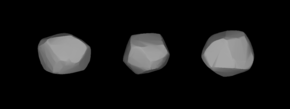34 Circe (original) (raw)
From Wikipedia, the free encyclopedia
Main-belt asteroid
34 Circe
 A three-dimensional model of 34 Circe based on its light curve A three-dimensional model of 34 Circe based on its light curve |
|
|---|---|
| Discovery | |
| Discovered by | J. Chacornac |
| Discovery date | April 6, 1855 |
| Designations | |
| Designation | (34) Circe |
| Pronunciation | [1] |
| Named after | Circe |
| Alternative names | 1965 JL |
| Minor planet category | Main belt |
| Adjectives | Circean [2] |
| Orbital characteristics[3] | |
| Epoch November 4, 2013 (JD 2456600.5) | |
| Aphelion | 2.967739 AU |
| Perihelion | 2.406230 AU |
| Semi-major axis | 2.686984 AU |
| Eccentricity | 0.1045 |
| Orbital period (sidereal) | 4.40 a (1607.332 d) |
| Average orbital speed | 18.12 km/s |
| Mean anomaly | 39.80474° |
| Inclination | 5.498° |
| Longitude of ascending node | 184.44157° |
| Argument of perihelion | 330.2330° |
| Physical characteristics | |
| Dimensions | 113.02 ± 4.90 km[4] |
| Mass | (3.66 ± 0.03) × 1018 kg[4] |
| Mean density | 4.83 ± 0.63 g/cm3[4] |
| Surface gravity | ~0.0317 m/s² |
| Escape velocity | ~0.0600 km/s |
| Synodic rotation period | 0.5063 d (12.15 h) [3] |
| Albedo | 0.0541 [3] |
| Temperature | ~172 K |
| Spectral type | C |
| Absolute magnitude (H) | 8.51 |
34 Circe is a large, very dark main-belt asteroid. It was discovered by French astronomer J. Chacornac on April 6, 1855, and named after Circe, the bewitching queen of Aeaea island in Greek mythology.
The spectrum of this object matches a C-type asteroid, suggesting a carbonaceous composition. It has a cross-section size of 113 km and is orbiting the Sun with a period of 4.40 years. Photometric observations of this asteroid made during 2007 at the Organ Mesa Observatory in Las Cruces, New Mexico gave an asymmetrical bimodal light curve with a period of 12.176 ± 0.002 hours and a brightness variation of 0.17 ± 0.02 in magnitude.[5] The spectra of the asteroid displays evidence of aqueous alteration.[6]
- ^ "Circe". Lexico UK English Dictionary. Oxford University Press. Archived from the original on 22 March 2020.
- ^ "Circean". Oxford English Dictionary (Online ed.). Oxford University Press. (Subscription or participating institution membership required.)
- ^ a b c Yeomans, Donald K., "34 Circe", JPL Small-Body Database Browser, NASA Jet Propulsion Laboratory, retrieved 21 December 2013.
- ^ a b c Carry, B. (December 2012), "Density of asteroids", Planetary and Space Science, 73 (1): 98–118, arXiv:1203.4336, Bibcode:2012P&SS...73...98C, doi:10.1016/j.pss.2012.03.009, S2CID 119226456. See Table 1.
- ^ Pilcher, Frederick (September 2008), "Period Determinations for 26 Proserpina, 34 Circe 74 Galatea, 143 Adria, 272 Antonia, 419 Aurelia, and 557 Violetta", The Minor Planet Bulletin, 35 (3): 135–138, Bibcode:2008MPBu...35..135P.
- ^ Fornasier, S.; et al. (February 1999), "Spectroscopic comparison of aqueous altered asteroids with CM2 carbonaceous chondrite meteorites", Astronomy and Astrophysics Supplement, 135: 65−73, Bibcode:1999A&AS..135...65F, doi:10.1051/aas:1999161.
- 34 Circe at AstDyS-2, Asteroids—Dynamic Site
- 34 Circe at the JPL Small-Body Database
